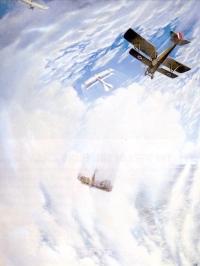| ________________
CM . . .
. Volume XIII Number 18 . . . . April 27, 2007
excerpt:
At Vimy Ridge tells the story of the capture by Canadian soldiers of a heavily fortified German position during the First World War. It does so with the help of many illustrations and is an accurate account, easy for young readers to follow. The book has no chapters, but letters in bold type are used to introduce the subjects being discussed. These include GAS!, STALEMATE AND SLAUGHTER, and TRENCH RAIDS. It is ideal for classroom use.
The book is well illustrated throughout with many, mainly black and white, photographs. A few are in colour, including reproductions of paintings and some dramatic shots of the Vimy Memorial. There are also some excellent maps. All the illustrations are functional. In addition, there is an index and a glossary of useful terms such as Fritz, puttees, and shrapnel. There is a small, but useful, bibliography. In 2007, some Canadians seem confused about their country's military history. Many feel that the presence of our troops in Afghanistan represents a change in the role of the armed forces from peacekeeping to one of waging war. While Canadian soldiers have served as peacekeepers, their reputation as soldiers waging war is much more accurate. This reputation was earned during the First World War where they proved, with their courage and bravery, that they were as good, perhaps better, than any other soldiers. It was reinforced in the Second World War, and in Korea and Croatia where they fought, in all cases, with great distinction. This reputation is certainly being upheld today in Afghanistan in the war against the Taliban. Few battles shows the skill and bravery of Canadian troops better than the battle for Vimy Ridge in France in 1917. A heavily fortified German position, the ridge had previously withstood French and British attacks. The Germans were unable, however, to hold back the Canadian assault which began on April 9th. For a number of reasons, in addition to bravery, including leadership and excellent planning, the Canadians overran the ridge and earned the reputation as the best troops in the British Expeditionary Force. Hugh Brewster, author of numerous books for children, including On Juno Beach, tells the Vimy Ridge story in a way young children will understand. While emphasizing the bravery of the Canadians, he also shows how horrible war can be. If there is a weakness in At Vimy Ridge, it is that Brewster does not explain why the British Empire went to war with Germany in 1914. Any child reading his book is bound to wonder why. A brief introduction explaining what led to the outbreak of war and who the participants were would have added significantly to the book's value. A minor matter concerns a soldier's salary, which in 1914 was $1.10 per day. This amount sounds so small in today's terms. The use of a footnote explaining how far that money went in 1914 would have been useful. Highly Recommended. Thomas F. Chambers, a retired college teacher, lives in North Bay, ON.
To comment on this
title or this review, send mail to cm@umanitoba.ca.
Copyright © the Manitoba Library Association. Reproduction for personal
use is permitted only if this copyright notice is maintained. Any
other reproduction is prohibited without permission.
NEXT REVIEW |TABLE OF CONTENTS FOR THIS ISSUE
- April 27, 2007.
AUTHORS
| TITLES | MEDIA REVIEWS
| PROFILES
| BACK ISSUES
| SEARCH | CMARCHIVE
| HOME |

